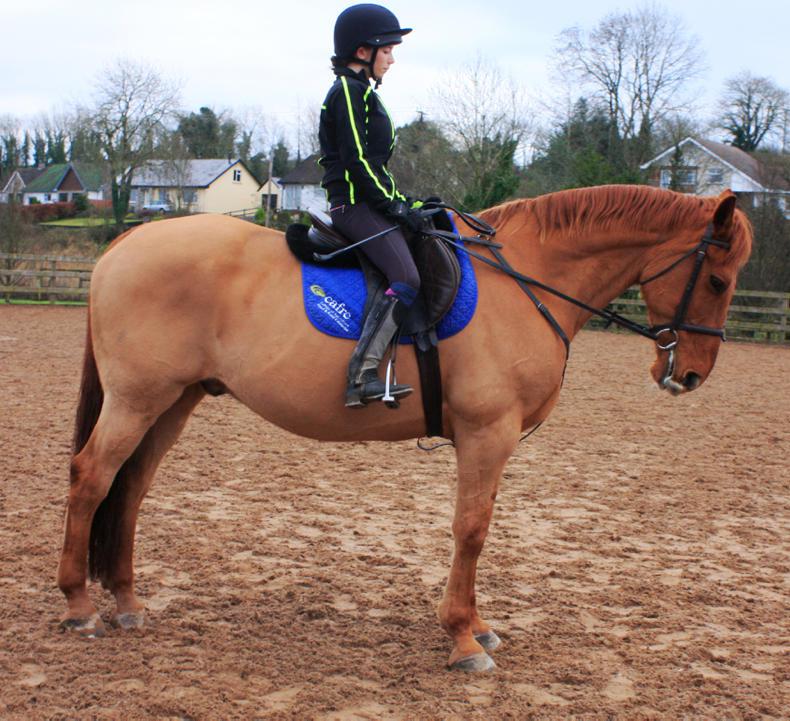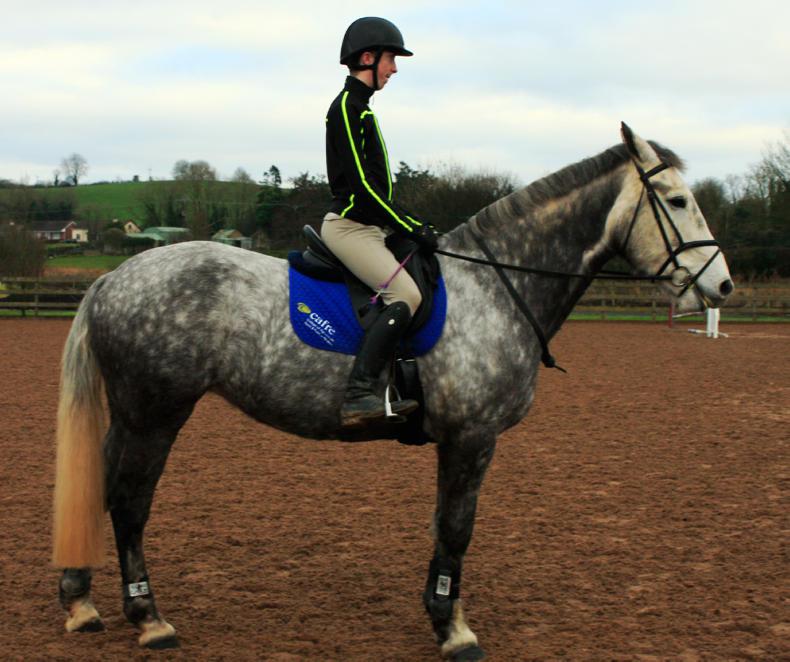THE novice rider has many aspects to contend with as they make their way through the development of their skill as a rider.
The majority of riders want to ride because of their love of horses and the ability to connect with them. They may start riding at a riding school or on a quiet horse/pony owned by their family or friend. This initial introduction to riding will either progress their skills at a spritely pace or set them up for a lifetime of just not quite getting it.
The majority of novice riders are usually able to describe a correct positional alignment, they can state that they should have their ear, shoulder, hip and heel in a straight line and there should be a straight line from their elbow to the bit etc. However, applying this to their own alignment sometimes gets lost in translation resulting in a wide range of positional issues that can result in the rider not having an independent seat and thus impacting on the horse’s way of going.
It is important that riders develop the ability to keep control of their balance so that they can stay over their centre of gravity. As Wanless (2008) says, if the horse was magically removed the rider should land in balance on their feet on the arena without tipping forwards or backwards.
Many novice riders are told that it is important to keep their heels down, however, this can sometimes be taken to the extreme with the whole leg coming forward and the rider’s weight ending up at the back of the saddle in the ‘water skiing’ or ‘chair position’. Although this is quite a secure position and can be adopted when the horse is playing up etc. it means that the rider is not entirely responsible for their weight, therefore, relying on their hands for balance.
This may result in them pulling on the reins which can cause the horse either to not want to go forward or encourage him to take hold of the bit and run on the forehand.
THE CORRECT SEAT
The rider will need to adjust their alignment and make sure their seat bones are pointing vertically. It is important that the novice rider gets the feel of where their seat bones are and how they come into contact with the saddle.
A good exercise to help determine this is to get a helper or an instructor to hold your horse (only attempt this if your horse is quiet and in no way skittish) then draw your seat towards the front of the saddle and place your two legs over the knee roll. Keeping your safety in mind, gently tilt your pelvis back and forward until you establish where your seat bones are. Then try and feel if you have weighted them evenly, as this can have an impact on how you sit in the saddle, does one feel heavier or lower than the other?
Once you have established this it is useful to determine what it feels like to point your seat bones forward (rounded back) and then backwards (hollow back) before trying to establish them in a vertical position. It is important that the novice rider gets to know what this feels like as it will help them with their alignment while in motion.
The type of saddle you are using, especially if it is very forward cut, can have a tendency to put the rider in the ‘chair seat’ and it takes quite a bit of core strength and body awareness to cope with this.

The rider pictured above is having this problem, as you can see from the Viualise jacket, her upper body position is fairly good but her lower leg is quite a bit away for the ear, shoulder, hip and heel alignment. This impacts on her ability to have a stable and strong lower leg, encourages her to pivot off the knee and, as you can see, the weight is all at the back of the saddle meaning that she is not taking responsibility for it.
BETTER ALIGNMENT
To help her towards a better alignment, she established where her seat bones were, aimed them in a more vertical position and then moved her thigh into a point that allows her lower leg to sit in the correct alignment and acts as a stabilising force (see image below).

The centre thigh seem of the rider’s jodhpurs is now closer to a 45° angle, however, she has dropped her hands which is causing her shoulders to slightly slump forward but overall she is in a more independent position. The novice rider needs to repeatedly establish the correct alignment, even if this means going back to halt and making the adjustments.
Setting up a ‘muscle memory’ of what the correct position feels like is important and this may also help their instructor as they can remind them to mimic the same feel while working through the gaits.
WORK WITHOUT STIRRUPS

The rider pictured above has got a decent ear, shoulder, hip and heel alignment, however, he is hollowing his back slightly and pointing his pelvis and seat bones towards the back of this saddle. This can be a result of a novice rider interpreting the instruction to ‘sit tall’ as meaning they should raise their rib cage and slightly hollow the lower back.
The overall result is that the hollow back has lost its flexibility and the tilted pelvis and seat bones restrict the rider from taking a deep stable seat. This position can also lead to novice riders experiencing back pain as the lower back and hips’ shock absorbency has been reduced.
A good instructor can encourage the novice rider to adjust their pelvic alignment and ask the rider to feel that the lower back is aimed more towards the waistband of their jodhpurs which may help them to visualise how they are aligning their pelvis. The use of sitting trot and riding without stirrups has always been a stable of developing a novice rider’s core strength and alignment and because of this you may find that novice riders feel you are ‘punishing’ them by making them practice it.
It does not help that the horse’s reaction to a novice rider bouncing on their back in an unbalance fashion, is usually to raise their head and become hollow, which makes it difficult to sit to. However, if the novice rider perseveres, becomes more body aware and stronger within their core, the rewards are worth it.
TOP TIPS
With our hectic everyday lives there is a tendency to take up a position or move in a way that is comfortable and takes little effort, this can also be exasperated by us favouring one side of our body, resulting in a more dominant stronger side.
If your daily activities involve sitting at a computer, in your car or standing for long periods of time it is easy to take up a position that does not involve much effort but this can make it more difficult to take up the correct position when riding especially if it is only once a week.
That is why you find that numerous top riders work on their core strength and alignment while unmounted. Whether it is going to a gym, taking up Pilates or yoga classes or using something like the Alexander Technique (which can help the rider to develop correct postural technique on and off the horse), this can help establish a more even posture and make the transition to riding a little less daunting.
There are many ways to help novice riders, someone videoing them riding on a regular basis can enable them to monitor how they are progressing and enable them to freeze the frame, assess their position and review how they handle a range of school movements.
There is an app called Coach My Video, which can be used by any sport. It allows you to upload photos and videos and assists you in analysing them. Numerous top quality riding centres offer lunge lessons on a quiet school horse where the novice rider can concentrate on their position and adapt to the horse’s movement within all three gaits.
YouTube has a variety of helpful videos offering guidance and advice on a range of riding issues. There are a number of sites that you can send riding videos to (usually for a small fee) where they will send back analysis, advice and tips on how to improve.
Whichever route the novice rider takes it is important to still keep in mind the enjoyment they gain from interacting with horses and how the love of horses is the main reason they took up the sport.